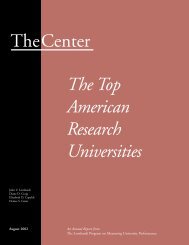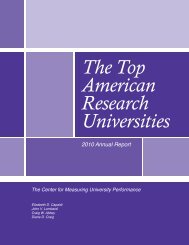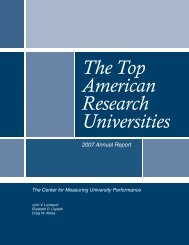The Top American Research Universities - The Center for ...
The Top American Research Universities - The Center for ...
The Top American Research Universities - The Center for ...
You also want an ePaper? Increase the reach of your titles
YUMPU automatically turns print PDFs into web optimized ePapers that Google loves.
Endowment Assets<br />
Source: NACUBO Endowment Study as reported in the<br />
Chronicle of Higher Education, endowment market value as<br />
of June 30, 2007.<br />
<strong>The</strong> <strong>Top</strong> <strong>American</strong> <strong>Research</strong> <strong>Universities</strong><br />
Institutions report the market value of their endowment assets<br />
as of June 30 to three different sources, and they quite often use<br />
three different values. For this project, we use the National Association<br />
of College and University Business Officers (NACUBO)<br />
Endowment Study because of NACUBO’s long history of reporting<br />
endowments of higher education institutions, their emphasis<br />
on using audited financial statements, and their focus on net assets<br />
(i.e., includes returns on investments and excludes investment fees<br />
and other withdrawals). NACUBO conducts its study annually<br />
and reports the results each February in the Chronicle of Higher<br />
Education.<br />
Another source <strong>for</strong> endowment assets is the Council <strong>for</strong> Aid to<br />
Education’s (CAE) annual Voluntary Support of Education (VSE)<br />
survey, cosponsored by the Council <strong>for</strong> Advancement and Support<br />
of Education (CASE) and the National Association of Independent<br />
Schools. <strong>The</strong> VSE survey is useful as a secondary resource because<br />
it provides more single-campus data than the other two<br />
sources. For those institutions that report a system-wide total to<br />
NACUBO, we often use the VSE data to calculate a campus’<br />
percentage contribution to the entire system, applying that factor<br />
to the NACUBO figure. In other cases, we may substitute the<br />
VSE figure when the institution indicates that this is a good data<br />
source.<br />
<strong>The</strong> National <strong>Center</strong> <strong>for</strong> Education Statistics (NCES) Integrated<br />
Postsecondary Education Data System (IPEDS) Finance Survey<br />
also collects in<strong>for</strong>mation on endowment assets, but these figures<br />
are often much lower than the two other sources and also are<br />
available much later. Although IPEDS instructions say to report<br />
endowment assets <strong>for</strong> “the institution and any of its foundations or<br />
affiliated organizations,” it appears that not all institutions do so.<br />
<strong>The</strong> fact that the NACUBO study requests net assets, while<br />
IPEDS and the VSE survey request gross assets, cannot explain<br />
the large differences found in some cases. In calling various institutions,<br />
we found it very difficult to determine exactly why the<br />
numbers vary so greatly. Oftentimes, two or more individuals at<br />
an institution independently report figures <strong>for</strong> these three reports<br />
with no clear understanding of how or why the numbers differ.<br />
An examination of the 1997 endowment figures provided by these<br />
institutions showed only one university (University of North<br />
Carolina at Chapel Hill) that submitted the same figure to each<br />
of the three organizations. We discovered no consistent pattern<br />
to explain reporting variations among the institutions. This area<br />
definitely warrants more study.<br />
Annual Giving<br />
Source: Council <strong>for</strong> Aid to Education’s Voluntary Support of<br />
Education (VSE) Survey, FY 2007.<br />
<strong>The</strong> Council <strong>for</strong> Aid to Education (CAE), an independent subsidiary<br />
of RAND, has produced the Voluntary Support of Education<br />
(VSE) Survey since 1986. <strong>The</strong> annual giving data include all<br />
contributions actually received during the institution’s fiscal year<br />
in the <strong>for</strong>m of cash, securities, company products, and other property<br />
from alumni, non-alumni individuals, corporations, foundations,<br />
religious organizations, and other groups. Not included in<br />
the totals are public funds, earnings on investments held by the<br />
institution, and unfulfilled pledges.<br />
CAE's VSE Data Miner service, available on-line, provides 10<br />
years of data <strong>for</strong> all participating institutions (more than 1,600<br />
universities and colleges). Although this is a subscription-based<br />
service and requires a user ID and password, limited access is<br />
available on-line at [http://www.cae.org/vse].<br />
National Academy Members<br />
Source: National Academy of Sciences, National Academy of<br />
Engineering, and Institute of Medicine membership directories<br />
<strong>for</strong> 2007.<br />
One of the highest honors that academic faculty can receive<br />
is membership in the National Academy of Sciences (NAS), the<br />
National Academy of Engineering (NAE), or the Institute of<br />
Medicine (IOM). All three are private, nonprofit organizations and<br />
serve as advisors to the federal government on science, technology,<br />
and medicine. Nominated and voted on by active members,<br />
newly elected members of these organizations receive life terms.<br />
Individuals elected to membership come from all sectors—academia,<br />
industry, government, and not-<strong>for</strong>-profit agencies or organizations.<br />
Member election dates are in February (NAE), April<br />
(NAS), and October (IOM).<br />
<strong>The</strong> data collected <strong>for</strong> these rankings use active or emeritus<br />
members at their affiliated work institution, as reported in the<br />
on-line membership directories. In all cases, we were able to<br />
determine the specific campus <strong>for</strong> individual members. We<br />
re-check institutional affiliation annually to account <strong>for</strong> established<br />
members who have changed employers or whose<br />
membership is no longer active.<br />
Faculty Awards in the Arts, Humanities, Science,<br />
Engineering, and Health<br />
Source: Directories or web-based listings <strong>for</strong> multiple agencies<br />
or organizations.<br />
For this category, we collect data from several prominent<br />
grant and fellowship programs in the arts, humanities, science,<br />
2008 Annual Report<br />
213








